Contact Us
For more information on breast augmentation, or to schedule a consultation, please contact us today.
Breast augmentation (breast enlargement) is one of the most popular procedures in cosmetic surgery. In most patients, breast implants are inserted into the tissue to create the appearance of larger breasts. There are a number of reasons why an individual might desire breast enhancement, including to improve the fit of clothing and to develop a more proportional figure. Some patients may wish to restore their pre-pregnancy body with a mommy makeover, and other patients may simply want to feel better about their overall shape.
No matter why you are seeking a breast augmentation, plastic surgeon David L. Durst can develop a custom-designed treatment plan around your aesthetic goals for a final outcome that complements your unique figure and silhouette. Patients who undergo breast augmentation can typically achieve improved breast proportions as well as an enhanced body contour.
Augmentation surgery can yield a number of benefits for patients who wish to enhance their breast appearance. With a range of implant types and sizes to choose from, the procedure can generally reshape and enlarge the breasts according to your desired aesthetic. The potential benefits of breast augmentation include:
Every detail of breast augmentation, including the most ideal incision location, implant location, implant type, and implant size, is tailored according to your preferences and cosmetic wishes for the results. During a consultation, Dr. Durst can help you determine the best choices to fulfill your goals for surgery while attaining a natural-looking outcome.
Of course, most people are concerned about size. Breast implants do come in different sizes (and shapes), and it is important to pick the right size for each patient. Dr. Durst will help individuals understand what the pluses and minuses of different sizes are and what will look best based on patient goals. Several different techniques can be used to help with the pre-surgical planning utilized for each patient.
Silicone breast implants are approved by the U.S. Food and Administration for individuals aged 22 and over. These popular implants are composed of a silicone shell, which is filled with a thick gel that is also made of silicone. Silicone breast implants are known for their ability to create a very natural appearance, and there is typically less risk of “rippling” with these implants. They can often be ideal for patients who are very thin. In the unlikely event that the implant ruptures, the silicone gel should remain stable inside the shell; however, this also makes ruptures less noticeable.
Saline breast implants are FDA-approved for patients who are 18 years of age and older. These implants can also yield very natural-looking results, and residual scarring is often minimal due to the fact that a saline implant can be filled after it has been inserted into the breast pocket. In the rare case of implant rupture, the saline (salt-water solution) inside the implant can be easily absorbed by the body until the implant is removed.
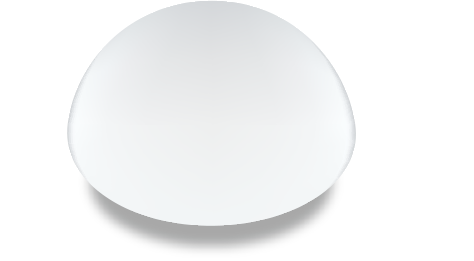 The size you choose for your breast implants is an important consideration; however, it’s equally important to consider how the shape of the implants will affect overall proportions. The results of breast augmentation should enhance your silhouette, which means that the rate of projection, the potential effect on your profile, and the volume of the breast implants should all be taken into account when choosing the best option for your needs and goals.
The size you choose for your breast implants is an important consideration; however, it’s equally important to consider how the shape of the implants will affect overall proportions. The results of breast augmentation should enhance your silhouette, which means that the rate of projection, the potential effect on your profile, and the volume of the breast implants should all be taken into account when choosing the best option for your needs and goals.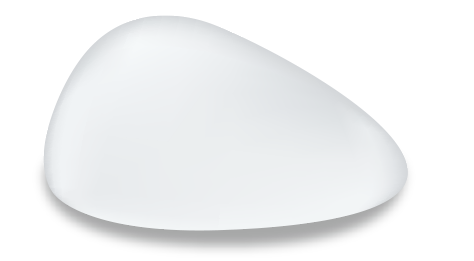 During your initial consultation with Dr. Durst, he will show you a variety of breast implant options. You can hold some of the implants in your hand and even try them on for size to get a general idea of the potential results. Choosing your breast implants is one of the most important steps in the process, and Dr. Durst can help you determine which type, size, and shape of implant can meet your goals with the most natural and flattering results.
During your initial consultation with Dr. Durst, he will show you a variety of breast implant options. You can hold some of the implants in your hand and even try them on for size to get a general idea of the potential results. Choosing your breast implants is one of the most important steps in the process, and Dr. Durst can help you determine which type, size, and shape of implant can meet your goals with the most natural and flattering results.During the breast enlargement procedure, Dr. Durst will insert the breast implants into pockets in the tissue. This is generally done as an outpatient surgery under general anesthesia. Implants are placed either under the muscle or over the muscle as determined by Dr. Durst’s personal evaluation of what will work best. The use of implants in surgery involves many different choices. Either saline or silicone implants can be utilized. Again, it takes Dr. Durst’s examination and thorough discussion with the patient to determine which choice would be best for each surgery. Incisions are usually made in the crease under the breast. There are variables for each individual patient, and these will be fully discussed during a consultation.
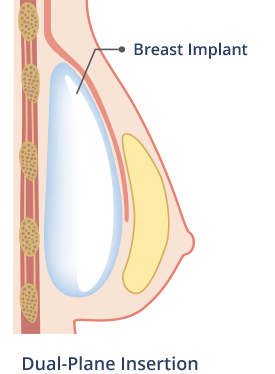
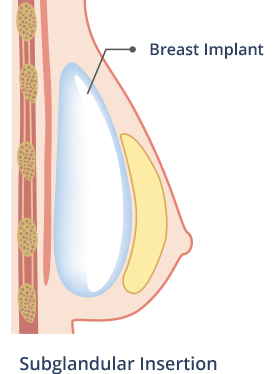
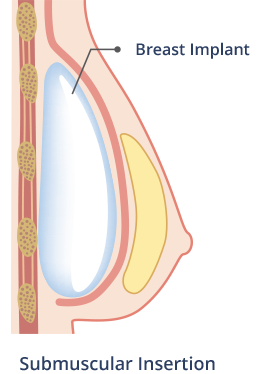
A breast implant can either be inserted over the chest muscle (subglandular) or under the chest muscle (submuscular). Dr. Durst will go over the best approach for your needs during a consultation, but in general, the best implant placement for you depends on your anatomical needs.
If you have naturally thin breast skin or a smaller body frame, placing your breast implants under the chest muscle is usually recommended to help ensure the edges of the implant are undetectable. In this location, the overlying muscle can provide enough coverage for the implant to reduce the risk of implant rippling.
In contrast, patients with an adequate amount of breast tissue may prefer to place their implants over the chest muscle. This approach often leads to less discomfort during the recovery period, but can increase the risk of capsular contracture (scar tissue development) in the future. Dr. Durst will suggest the technique that is most likely to produce refined and natural-looking results.
Breast augmentation is generally done as an outpatient procedure, meaning that the patient can go home the same day. Dressings are used to protect the treated area post-surgery. Some soreness is normal, and there are medications to control discomfort. Generally, patients take about a week off from work. Aftercare regarding bras and activities are individualized for each patient, but generally patients can start exercising lightly by walking at two weeks and resume full sports at about four weeks. Some exercises should be avoided long term subsequent to breast augmentation, and Dr. Durst will discuss these matters with each patient.
Early on, breasts may feel tight and appear somewhat artificial. As the swelling goes down, most patients notice significant improvement about a week or two after surgery, and after approximately four weeks, patients should begin to see the final results.
Internally, it takes a year for tissue to completely heal; however, most of these changes occur in the first six weeks. By that time, most patients can be relatively confident about their new breast size. Photos are usually taken at two months for comparison with preoperative appearance. Long term care is individualized for each patient depending on their work, sports activities, and type of implants, and this requires in-depth discussion. Dr. Durst believes that long term follow-up care after breast implant surgery is important, and he continues to see patients once a year for as long as they want to come.
The lifespan of breast implants varies from patient to patient, but they can remain in good condition for 15 years on average. Complications that may warrant an implant exchange include:
A rupture in a saline implant should be visible with an obvious change in the shape or positioning of your breasts. However, a leak in silicone implants may be more difficult to notice, as the structure typically remains stable in the event of rupture. This is why it is imperative for those with silicone implants to undergo imaging as soon as they notice a change in the appearance of their breasts. If a complication does arise, or if patients simply want to upgrade to a different implant type, size, or shape, breast revision surgery can be pursued to remove or exchange implants.
Breast implants should not affect the ability to breastfeed if you were able to nurse before surgery. The most important thing to remember if you have future plans for breastfeeding is to communicate your desires with Dr. Durst. This can allow him to perform your breast augmentation in a way that avoids damaging the mechanisms responsible for milk production, maximizing your chances of successful breastfeeding after the procedure. That said, Dr. Durst generally recommends postponing breast augmentation until after all plans for nursing are complete, if possible. While lactating function can be preserved during breast augmentation, breastfeeding can also cause increased skin laxity and the development of breast sag, potentially compromising the volume enhancement achieved with surgery.
Breast augmentation scars generally resemble the incision used to place the implants; therefore, your scar will likely appear within the natural fold of the breast crease. Dr. Durst typically utilizes the inframammary incision to place implants, as this location can accommodate insertion of both small and large implants while providing a clear access point for positioning under or over the chest muscle. Dr. Durst will take every measure to make all scarring as discreet as possible, and patients can further promote the fading of their scars by following his post-operative instructions on proper incision care.
As breast augmentation is a completely personalized procedure, the cost of surgery will vary from patient to patient, and doctor to doctor. The factors that generally affect the expense associated with breast augmentation include:
While the true price of your augmentation surgery cannot be calculated until your needs are evaluated in a consultation, the average cost of the procedure can run anywhere from $5,100 to $6,200. Our office will be able to provide a more personalized quote once you visit Dr. Durst, but this estimate can be helpful when researching breast augmentation.
In addition to accepting all major payment methods, our office works with CareCredit® and Prosper® Healthcare Lending, highly reputable plastic surgery financing companies that can help make the cost of your treatment more affordable. If approved through the simple application process associated with either option, you can choose from a range of payment plans with low monthly installments to bring the price of breast augmentation into budget. If you have any questions, please don’t hesitate to reach out to our practice and speak to a friendly member of our team.
Wearing a bra after your procedure typically helps to protect your incisions, reduce swelling, keep your sutures in place, and facilitate your new breast shape. Dr. Durst will discuss the best type of bra to wear after breast augmentation, as well as how long you should wear it during the healing process. This advice is personalized according to the unique details of your enhancement.
Most cases of BIA-ALCL are only associated with a specific type of textured breast implant known as BioCell® implants. These models have since been voluntarily recalled by Allergan® and are no longer in circulation. In abundance of caution, Dr. Durst does not place textured implants at his practice altogether.
The FDA characterizes the risk of developing BIA-ALCL as very low; however, patient education is key to properly assessing the benefits and risks of breast augmentation. Our team encourages you to communicate your questions and concerns to Dr. Durst during your consultation.
Most patients take at least one week to recover before returning to work or school, although individuals often feel well enough to perform light activities within a few days. That said, physical labor and strenuous work responsibilities should be avoided for at least four weeks. Each person’s unique rate of healing varies, and recovery time usually depends on the details of their procedure.
Swelling should naturally resolve as your body heals from surgery. In the meantime, over-the-counter/prescribed pain medications as well as ice packs can be used as necessary to minimize swelling during recovery. It’s also important to wear your surgical bra according to Dr. Durst’s recommendations, and closely follow his aftercare instructions to facilitate proper healing.
For more information on breast augmentation, or to schedule a consultation, please contact us today.